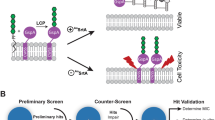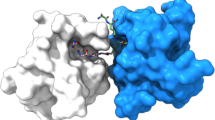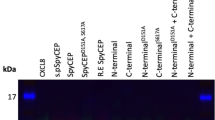Abstract
Serine hydrolases play diverse roles in regulating host–pathogen interactions in a number of organisms, yet few have been characterized in the human pathogen Staphylococcus aureus. Here we describe a chemical proteomic screen that identified ten previously uncharacterized S. aureus serine hydrolases that mostly lack human homologs. We termed these enzymes fluorophosphonate-binding hydrolases (FphA–J). One hydrolase, FphB, can process short fatty acid esters, exhibits increased activity in response to host cell factors, is located predominantly on the bacterial cell surface in a subset of cells, and is concentrated in the division septum. Genetic disruption of fphB confirmed that the enzyme is dispensable for bacterial growth in culture but crucial for establishing infection in distinct sites in vivo. A selective small molecule inhibitor of FphB effectively reduced infectivity in vivo, suggesting that it may be a viable therapeutic target for the treatment or management of Staphylococcus infections.
This is a preview of subscription content, access via your institution
Access options
Access Nature and 54 other Nature Portfolio journals
Get Nature+, our best-value online-access subscription
$29.99 / 30 days
cancel any time
Subscribe to this journal
Receive 12 print issues and online access
$259.00 per year
only $21.58 per issue
Buy this article
- Purchase on Springer Link
- Instant access to full article PDF
Prices may be subject to local taxes which are calculated during checkout






Similar content being viewed by others
References
Reddy, P. N., Srirama, K. & Dirisala, V. R. An update on clinical burden, diagnostic tools, and therapeutic options of Staphylococcus aureus. Infect. Dis. (Auckl.) 10, 1179916117703999 (2017).
Tong, S. Y., Davis, J. S., Eichenberger, E., Holland, T. L. & Fowler, V. G. Jr. Staphylococcus aureus infections: epidemiology, pathophysiology, clinical manifestations, and management. Clin. Microbiol. Rev. 28, 603–661 (2015).
Laupland, K. B. et al. The changing epidemiology of Staphylococcus aureus bloodstream infection: a multinational population-based surveillance study. Clin. Microbiol. Infect. 19, 465–471 (2013).
Duthie, E. S. & Lorenz, L. L. Staphylococcal coagulase; mode of action and antigenicity. J. Gen. Microbiol. 6, 95–107 (1952).
Frees, D., Gerth, U. & Ingmer, H. Clp chaperones and proteases are central in stress survival, virulence and antibiotic resistance of Staphylococcus aureus. Int. J. Med. Microbiol. 304, 142–149 (2014).
Staub, I. & Sieber, S. A. Beta-lactam probes as selective chemical-proteomic tools for the identification and functional characterization of resistance associated enzymes in MRSA. J. Am. Chem. Soc. 131, 6271–6276 (2009).
Frankel, M. B., Hendrickx, A. P., Missiakas, D. M. & Schneewind, O. LytN, a murein hydrolase in the cross-wall compartment of Staphylococcus aureus, is involved in proper bacterial growth and envelope assembly. J. Biol. Chem. 286, 32593–32605 (2011).
Bukowski, M., Wladyka, B. & Dubin, G. Exfoliative toxins of Staphylococcus aureus. Toxins (Basel) 2, 1148–1165 (2010).
Pietrocola, G., Nobile, G., Rindi, S. & Speziale, P. Staphylococcus aureus manipulates innate immunity through own and host-expressed proteases. Front. Cell. Infect. Microbiol. 7, 166 (2017).
Böttcher, T. & Sieber, S. A. Beta-lactones as specific inhibitors of ClpP attenuate the production of extracellular virulence factors of Staphylococcus aureus. J. Am. Chem. Soc. 130, 14400–14401 (2008).
Liu, Y., Patricelli, M. P. & Cravatt, B. F. Activity-based protein profiling: the serine hydrolases. Proc. Natl Acad. Sci. USA 96, 14694–14699 (1999).
Patricelli, M. P., Giang, D. K., Stamp, L. M. & Burbaum, J. J. Direct visualization of serine hydrolase activities in complex proteomes using fluorescent active site-directed probes. Proteomics 1, 1067–1071 (2001).
Simon, G. M. & Cravatt, B. F. Activity-based proteomics of enzyme superfamilies: serine hydrolases as a case study. J. Biol. Chem. 285, 11051–11055 (2010).
Henness, S. & Perry, C. M. Orlistat: a review of its use in the management of obesity. Drugs 66, 1625–1656 (2006).
Thornberry, N. A. & Weber, A. E. Discovery of JANUVIA (Sitagliptin), a selective dipeptidyl peptidase IV inhibitor for the treatment of type 2 diabetes. Curr. Top. Med. Chem. 7, 557–568 (2007).
Kluge, A. F. & Petter, R. C. Acylating drugs: redesigning natural covalent inhibitors. Curr. Opin. Chem. Biol. 14, 421–427 (2010).
Adam, G. C., Sorensen, E. J. & Cravatt, B. F. Chemical strategies for functional proteomics. Mol. Cell. Proteomics 1, 781–790 (2002).
Leung, D., Hardouin, C., Boger, D. L. & Cravatt, B. F. Discovering potent and selective reversible inhibitors of enzymes in complex proteomes. Nat. Biotechnol. 21, 687–691 (2003).
Jessani, N., Liu, Y., Humphrey, M. & Cravatt, B. F. Enzyme activity profiles of the secreted and membrane proteome that depict cancer cell invasiveness. Proc. Natl Acad. Sci. USA 99, 10335–10340 (2002).
Ortega, C. et al. Systematic survey of serine hydrolase activity in Mycobacterium tuberculosis defines changes associated with persistence. Cell Chem. Biol. 23, 290–298 (2016).
Tallman, K. R., Levine, S. R. & Beatty, K. E. Small-molecule probes reveal esterases with persistent activity in dormant and reactivating Mycobacterium tuberculosis. ACS Infect. Dis. 2, 936–944 (2016).
Hatzios, S. K. et al. Chemoproteomic profiling of host and pathogen enzymes active in cholera. Nat. Chem. Biol. 12, 268–274 (2016).
Zweerink, S. et al. Activity-based protein profiling as a robust method for enzyme identification and screening in extremophilic Archaea. Nat. Commun. 8, 15352 (2017).
Hall, C. I. et al. Chemical genetic screen identifies Toxoplasma DJ-1 as a regulator of parasite secretion, attachment, and invasion. Proc. Natl Acad. Sci. USA 108, 10568–10573 (2011).
Lentz, C. S. et al. Design of selective substrates and activity-based probes for Hydrolase Important for Pathogenesis 1 (HIP1) from Mycobacterium tuberculosis. ACS Infect. Dis. 2, 807–815 (2016).
Cadieux, B., Vijayakumaran, V., Bernards, M. A., McGavin, M. J. & Heinrichs, D. E. Role of lipase from community-associated methicillin-resistant Staphylococcus aureus strain USA300 in hydrolyzing triglycerides into growth-inhibitory free fatty acids. J. Bacteriol. 196, 4044–4056 (2014).
Rosenstein, R. & Gotz, F. Staphylococcal lipases: biochemical and molecular characterization. Biochimie 82, 1005–1014 (2000).
Nguyen, M. T. et al. Staphylococcal (phospho)lipases promote biofilm formation and host cell invasion. Int. J. Med. Microbiol. https://doi.org/10.1016/j.ijmm.2017.11.013 (2017).
Staub, I. & Sieber, S. A. Beta-lactams as selective chemical probes for the in vivo labeling of bacterial enzymes involved in cell wall biosynthesis, antibiotic resistance, and virulence. J. Am. Chem. Soc. 130, 13400–13409 (2008).
Fey, P. D. et al. A genetic resource for rapid and comprehensive phenotype screening of nonessential Staphylococcus aureus genes. MBio 4, e00537–e12 (2013).
Utaida, S. et al. Genome-wide transcriptional profiling of the response of Staphylococcus aureus to cell-wall-active antibiotics reveals a cell-wall-stress stimulon. Microbiology 149, 2719–2732 (2003).
Pietiäinen, M. et al. Transcriptome analysis of the responses of Staphylococcus aureus to antimicrobial peptides and characterization of the roles of vraDE and vraSR in antimicrobial resistance. BMC Genomics 10, 429 (2009).
Sass, P. et al. The lantibiotic mersacidin is a strong inducer of the cell wall stress response of Staphylococcus aureus. BMC Microbiol. 8, 186 (2008).
Muthaiyan, A. et al. Antimicrobial effect and mode of action of terpeneless cold-pressed Valencia orange essential oil on methicillin-resistant Staphylococcus aureus. J. Appl. Microbiol. 112, 1020–1033 (2012).
Palazzolo-Ballance, A. M. et al. Neutrophil microbicides induce a pathogen survival response in community-associated methicillin-resistant Staphylococcus aureus. J. Immunol. 180, 500–509 (2008).
Bore, E., Langsrud, S., Langsrud, O., Rode, T. M. & Holck, A. Acid-shock responses in Staphylococcus aureus investigated by global gene expression analysis. Microbiology 153, 2289–2303 (2007).
Neumann, Y. et al. The effect of skin fatty acids on Staphylococcus aureus. Arch. Microbiol. 197, 245–267 (2015).
Garland, M. et al. Development of an activity-based probe for acyl-protein thioesterases. PLoS One 13, e0190255 (2018).
Jinno, A. & Park, P. W. Role of glycosaminoglycans in infectious disease. Methods Mol. Biol. 1229, 567–585 (2015).
van Gemst, J. J. et al. RNA contaminates glycosaminoglycans extracted from cells and tissues. PLoS One 11, e0167336 (2016).
Raz, A. & Fischetti, V. A. Sortase A localizes to distinct foci on the Streptococcus pyogenes membrane. Proc. Natl Acad. Sci. USA 105, 18549–18554 (2008).
Mazmanian, S. K., Liu, G., Jensen, E. R., Lenoy, E. & Schneewind, O. Staphylococcus aureus sortase mutants defective in the display of surface proteins and in the pathogenesis of animal infections. Proc. Natl Acad. Sci. USA 97, 5510–5515 (2000).
Clarke, A. J. & Dupont, C. O-Acetylated peptidoglycan: its occurrence, pathobiological significance, and biosynthesis. Can. J. Microbiol. 38, 85–91 (1992).
Bera, A., Biswas, R., Herbert, S. & Gotz, F. The presence of peptidoglycan O-acetyltransferase in various staphylococcal species correlates with lysozyme resistance and pathogenicity. Infect. Immun. 74, 4598–4604 (2006).
Brown, S. et al. Methicillin resistance in Staphylococcus aureus requires glycosylated wall teichoic acids. Proc. Natl Acad. Sci. USA 109, 18909–18914 (2012).
Winstel, V. et al. Wall teichoic acid glycosylation governs Staphylococcus aureus nasal colonization. MBio 6, e00632–15 (2015).
Weadge, J. T. & Clarke, A. J. Identification and characterization of O-acetylpeptidoglycan esterase: a novel enzyme discovered in Neisseria gonorrhoeae. Biochemistry 45, 839–851 (2006).
Weadge, J. T., Pfeffer, J. M. & Clarke, A. J. Identification of a new family of enzymes with potential O-acetylpeptidoglycan esterase activity in both Gram-positive and Gram-negative bacteria. BMC Microbiol. 5, 49 (2005).
Rahman, M. M. et al. The Staphylococcus aureus methicillin resistance factor FmtA is a d-amino esterase that acts on teichoic acids. MBio 7, e02070–e15 (2016).
Garcia-Fernandez, E. et al. Membrane microdomain disassembly inhibits MRSA antibiotic resistance. Cell 171, 1354–1367.e20 (2017).
Pang, Y. Y. et al. agr-dependent interactions of Staphylococcus aureus USA300 with human polymorphonuclear neutrophils. J. Innate Immun. 2, 546–559 (2010).
Weerapana, E., Speers, A. E. & Cravatt, B. J. Tandem orthogonal proteolysis-activity-based protein profiling (TOP-ABPP)-a general method for mapping sites of probe modification in proteomes. Nat. Protoc. 2, 1414–1425 (2007).
Acknowledgements
We thank A. Horswill (University of Iowa) for sharing the GFP plasmid pCM29. We thank N. Amara and J. Yim for help with NMR analyses and S. Chen for LC-MS analysis of JCP678, and L. Popov, O. Zurek, J. Romaniuk and L. Cegelski for discussions. We also thank E. Yeh for access to the BD Accuri flow cytometer. C.S.L. was supported through a postdoctoral research fellowship by the German Research Foundation (DFG). This work was further supported through NIH grants 1R01GM111703 and R01EB026332 to M.B., 1R01GM117004 and 1R01GM118431-01A1 to E.W., 1R01AI101171 and 1R01AI069233 to E.P.S., and R21AI117255 to M.R.A.
Author information
Authors and Affiliations
Contributions
C.S.L. and M.B. conceived the project. C.S.L designed and performed the in vitro experiments, synthesized compounds and analyzed data. J.R.S. designed and performed the in vivo infection experiments and the genetic manipulation of S. aureus, and analyzed data. L.A.C. and E.W. performed LC-MS/MS analysis. R.C. contributed to the comparative bacterial labeling experiments. M.G. synthesized compounds. M.R.A. contributed to the experimental design and analyzed data. E.P.S. designed and analyzed in vivo infection experiments. M.B. supervised the project, designed experiments and analyzed data. C.S.L. and M.B. wrote the manuscript, and all authors reviewed, discussed and edited the manuscript.
Corresponding author
Ethics declarations
Competing interests
The authors declare no competing interests.
Additional information
Publisher’s note: Springer Nature remains neutral with regard to jurisdictional claims in published maps and institutional affiliations.
Rights and permissions
About this article
Cite this article
Lentz, C.S., Sheldon, J.R., Crawford, L.A. et al. Identification of a S. aureus virulence factor by activity-based protein profiling (ABPP). Nat Chem Biol 14, 609–617 (2018). https://doi.org/10.1038/s41589-018-0060-1
Received:
Accepted:
Published:
Issue Date:
DOI: https://doi.org/10.1038/s41589-018-0060-1
This article is cited by
-
Bactericidal bissulfone B7 targets bacterial pyruvate kinase to impair bacterial biology and pathogenicity in plants
Science China Life Sciences (2024)
-
Chemoproteomic identification of a DPP4 homolog in Bacteroides thetaiotaomicron
Nature Chemical Biology (2023)
-
Identification of highly selective covalent inhibitors by phage display
Nature Biotechnology (2021)
-
Tools for the discovery of biopolymer producing cysteine relays
Biophysical Reviews (2021)
-
Enzymes engineered to trap reaction intermediates
Nature (2019)



